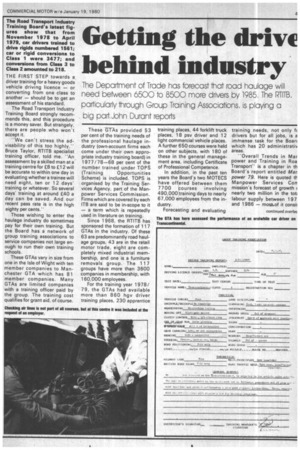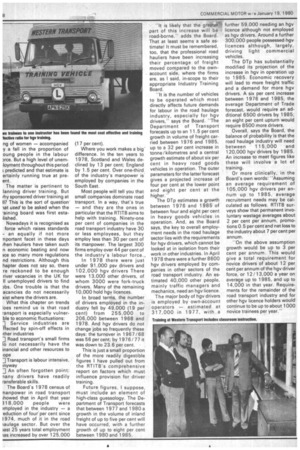Getting the drive behind industry
Page 49

Page 50

If you've noticed an error in this article please click here to report it so we can fix it.
The Deparment of Trace has forecast that road haulage will need be-ween 6500 to 8500 more drivers by 1985. The RTITB, particularly --Tough Group Training Associations, is playing a big patJohn Durant reports
THE FIRST STEP towards a, driver training for a heavy goods vehicle driving licence — or converting from one class to another — should be to get an assessment of his standard.
The Road Transport Industry Training Board strongly recommends this, and this procedure is a money saver. But strangely, there are people who won't accept it.
"We can't stress the advisability of this too highly," Bruce Taylor, RTITB specialist training officer, told me. "An_ assessment by a skilled man at a training centre for £8 to £12 will be accurate to within one day in evaluating whether a trainee will need eight, ten or 12 days' training or whatever. So several days' training at around £40 a day can be saved. And our recent pass rate is in the high eighty per cents."
Those wishing to enter the haulage industry do sometimes pay for their own training. But the Board has a network of group training associations to service companies not large enough to run their own training schools.
These GTAs vary in size from one in the Isle of Wight with ten member companies to Manchester GTA which has 81 member companies. Many GTAs are limited companies with a training officer paid by the group. The training cost qualifies for grant aid, of course. These TAs provided 53 per cent of the training needs of the professional haulage industry (own-account firms each come under their own appropriate industry training board) in 1977/78-68 per cent of the number trained under TOPS (Training Opportunities Scheme) is included. TOPS is organised by the Training Services Agency, part of the Manpower Services Commission. Firms which are covered by each ITB are said to be in-scope to it — a term which is repeatedly used in literature on training.
Since 1968, the RTITB has sponsored the formation of 117 GTAs in the industry. Of these 63 are predominantly road haulage groups, 43 are in the retail motor trade, eight are completely mixed industrial membership, and one is a furniture removals group. The 117 groups have more than 3600 companies in membership, with 160,000 employees.
For the training year 1978/ 79, the GTAs had available more than 860 hgv driver training places, 230 apprentice training places, 44 forklift truck places, 18 psv driver and 12 light commercial vehicle places. A further 650 courses were held on other subjects, with 180 of these in the general management area, including Certificate of Professional Competence.
In addition, in the past ten years the Board's two MOTECS have offered between them 7700 courses involving 490,000 training days to nearly 67,000 employees from the industry.
Forecasting and evaluating training needs, not only f( drivers but for all jobs, is a immense task for the Boar( which has 20 administrativ areas.
"Overall Trends in Mar power and Training in Roa Transport" is a chapter in th Board's report entitled Mar power 79. Here is quoted th Manpower Services Con mission's forecast of growth ( nearly two million in the tot labour supply between 197 and 1986 — most.of it consi; ng of women — accompanied y a fall in the proportion of oung people in the labour )rce. But a high level of unemloyment throughout this period ; predicted and that estimate is ertainly running true at preent.
The matter is pertinent to lanning driver training. But thy sponsored driver training at II? This is the sort of question lat used to be asked when the -aining board was first estalished Nowadays it is recognised as force which raises standards an equally if not more nportant facet in these days then hauliers have taken such n economic beating and now 3ce so many more regulations nd restrictions. Although this hapter does not say so, there re reckoned to be enough river vacancies in the UK for II unemployed drivers to find )bs. One trouble is that the acancies do not necessarily xist where the drivers are.
What this chapter on trends loes remind us is that road -ansport is especially vulnerble to economic fluctuations: ] Service industries are ffected by spin-off effects in rther industries Road transport's small firms lo not necessarily have the inancial and other resources to ope Transport is labour intensive, inyway An often forgotten point: lam/ drivers have readily ransferable skills.
The Board's 1 978 census of nanpower in road transport ;bowed that in April that year 318,000 people were )mployed in the industry — a eduction of four per cent since 1974, much of it in the road iaulage sector. But over the )ast 25 years total employment las increased by over 125,000 (17 per cent).
Where you work makes a big' difference. In the ten years to 1978, Scotland and Wales declined by 13 per cent; England by 1.5 per cent. Over one-third of the industry's manpower is employed by companies in the South East.
Most people will tell you that small companies dominate road transport. In a way, that's true — and they are the ones in particular that the RTITB aims to help with training. Ninety-one per cent of companies in the road transport industry have 30 or less employees, but they employ less than 30 per cent of its manpower. The largest 300 firms employ over 44 per cent of the industry's labour force., In 1978 there were just under 91,000 psv drivers and 102,000 hgv drivers There were 13,000 other drivers, of whom 3000 were fork-truck drivers. Many of the remaining 10,000 hold hgv licences.
In broad terms, the number of drivers employed in the industry fell by 49,000 (19 per cent) from 255,000 to 206,000 between 1968 and 1978. And hgv drivers do not change jobs so frequently these days: the turnover in 1967/68 was 56 per cent; by 1976/77 it was down to 23.6 per cent. • This is just a small proportion of the more readily digestible figures I have pulled out from the RTITB's comprehensive report on factors which must influence provision for driver training.
Future figures, I suppose, must include an element of high-class guessology. The Department of Transport forecasts that between 1977 and 1980 a growth in the volume of inland freight of up to five per cent will have occurred, with a further growth of up to eight per cent between 1980 and 1985. 'It is likely that the greater:' part of this increase will be road-borne," adds the Board. That at least seems a safe estimate! It must be remembered, too, that the professional road hauliers have been increasing their percentage of freight moved compared to the ownaccount side, where the firms are, as I said, in-scope to their appropriate Industry Training Board.
"It is the number of vehicles to be operated which most directly affects future demands for labour in the road haulage industry, especially for hgv drivers," says the Board. "The Department of Transport forecasts up to an 11.5 per cent growth in volume of freight carried between 1976 and 1985, up to a 32 per cent increase in tonne/kilometres and a central growth estimate of about six per cent in heavy road goods vehicles in operation. The outer parameters for the latter forecast gives a projected increase of four per cent at the lower point and eight per cent at the higher."
The DTp estimates a growth between 1976 and 1985 of between four and eight per cent in heavy goods vehicles in operation. And, as the Board says, the key to overall employment needs in the road haulage sector lies with the requirements for hgv drivers, which cannot be looked at in isolation from their work in other industries. In April 1978 there were a further 8600 hgv drivers employed by companies in other sectors of the road transport industry. An estimated 40,000 other people, mainly traffic managers and mechanics, need an hgv licence.
The major body of hgv drivers is employed by own-account operators — estimated at 317,000 in 1977, with a further 59,000 needing an hgv licence although not employed as hgv drivers. Around a further 300,000 people possessed hgv licences although, largely, driving light commercial vehicles.
The DTp has substantially modified its projection of the increase in hgv in operation up to 1985. Economic recovery will lead to more freight traffic and a demand for more hgv drivers. A six per cent increase between 1976 and 1985, the average Department of Trade forecast, would require an additional 6500 drivers by 1985; an eight per cent upturn would require 8500 more drivers.
Overall, says the Board, the balance of probability is that the road haulage industry will need between 115,000 and 120,000 hgv drivers by 1985. An increase to meet figures like these will involve a lot of training.
Or more clinically, in the Board's own words: "Assuming an average requirement of 105,000 hgv drivers per annum up to 1985, average recruitment needs may be calculated as follows. RTITB surveys show that permanent involuntary wastage averages about 2 per cent per annum, promotions 0.5 per cent and net loss to the industry about 7 per cent per annum.
"On the above assumption growth would be up to 3 per cent per annum. This would give a total requirement for novice drivers of about 12 per cent per annum of the hgv driver force, or 12/13,000 a year on average up to 1985, and up to 14,000 in that year. Requirements for the remainder of the road transport industry and for other hgv licence holders would continue to be up to about 1000 novice trainees per year."












































































































